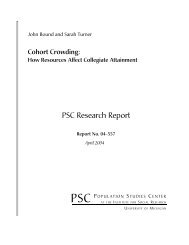Population Ageing and the Well-Being of Older Persons in Thailand ...
Population Ageing and the Well-Being of Older Persons in Thailand ...
Population Ageing and the Well-Being of Older Persons in Thailand ...
Create successful ePaper yourself
Turn your PDF publications into a flip-book with our unique Google optimized e-Paper software.
Also reassur<strong>in</strong>g is <strong>the</strong> f<strong>in</strong>d<strong>in</strong>g that material assistance<br />
from adult children has not dim<strong>in</strong>ished despite <strong>the</strong><br />
extensive social change that is <strong>of</strong>ten assumed to<br />
underm<strong>in</strong>e filial responsibility. Not only do <strong>the</strong> vast<br />
majority <strong>of</strong> elderly receive at least some <strong>in</strong>come from<br />
children but <strong>the</strong> per cent who <strong>in</strong>dicate that children<br />
are <strong>the</strong>ir ma<strong>in</strong> source <strong>of</strong> support has changed little<br />
dur<strong>in</strong>g <strong>the</strong> last decade or so. Likewise encourag<strong>in</strong>g<br />
are f<strong>in</strong>d<strong>in</strong>gs concern<strong>in</strong>g government welfare<br />
allowances. Not only has <strong>the</strong> share <strong>of</strong> older persons<br />
who receive <strong>the</strong>m very substantially <strong>in</strong>creased <strong>in</strong><br />
recent years but those <strong>in</strong> greatest need <strong>of</strong> assistance<br />
are far more likely to receive an allowance than those<br />
least <strong>in</strong> need. Thus <strong>the</strong> programmes is hav<strong>in</strong>g<br />
reasonable success <strong>in</strong> meet<strong>in</strong>g its orig<strong>in</strong>al goal. Still<br />
<strong>the</strong>re are likely significant numbers who sorely need<br />
f<strong>in</strong>ancial assistance but do not receive it.<br />
The situation regard<strong>in</strong>g gender equity among Thai<br />
elderly is also relatively positive. <strong>Older</strong> women have<br />
received less school<strong>in</strong>g than men but this disadvantage<br />
will decl<strong>in</strong>e steadily over <strong>the</strong> next few decades. <strong>Older</strong><br />
women are also far more likely than men to be<br />
widowed. However, for both men <strong>and</strong> women, not<br />
hav<strong>in</strong>g a spouse is not associated with lower perceived<br />
<strong>in</strong>come sufficiency or f<strong>in</strong>ancial satisfaction. Perhaps<br />
most encourag<strong>in</strong>g is that older men <strong>and</strong> women are<br />
similar with respect to <strong>the</strong> quality <strong>of</strong> <strong>the</strong>ir hous<strong>in</strong>g,<br />
household possessions, <strong>and</strong> self-assessed adequacy <strong>of</strong><br />
<strong>in</strong>come <strong>and</strong> satisfaction with f<strong>in</strong>ancial situation.<br />
Among married persons, women disproportionately<br />
report low personal <strong>in</strong>come <strong>and</strong> wealth compared to<br />
men but as wives <strong>the</strong>y may well benefit from <strong>the</strong><br />
husb<strong>and</strong>’s <strong>in</strong>come <strong>and</strong> wealth. Among unmarried<br />
older persons, women fare at least as well as men.<br />
<strong>Older</strong> men are substantially more likely than older<br />
women to be currently ga<strong>in</strong>fully employed, but it is<br />
unclear whe<strong>the</strong>r cont<strong>in</strong>u<strong>in</strong>g to work <strong>in</strong> old age is an<br />
advantage or disadvantage.<br />
Some results are less encourag<strong>in</strong>g <strong>and</strong> po<strong>in</strong>t to needs<br />
that should be taken <strong>in</strong>to account when formulat<strong>in</strong>g<br />
policy <strong>and</strong> programmes <strong>in</strong>tended to ensure <strong>the</strong><br />
security <strong>and</strong> improve <strong>the</strong> well-be<strong>in</strong>g <strong>of</strong> <strong>the</strong> elderly as<br />
population age<strong>in</strong>g proceeds. Substantial rural-urban<br />
disparity persists. Rural elderly are less educated, less<br />
literate, more likely to work, more dependent on <strong>the</strong>ir<br />
own work for support, <strong>and</strong> have substantially lower<br />
average <strong>in</strong>comes than <strong>the</strong>ir urban counterparts. They<br />
are also substantially more likely to <strong>in</strong>dicate that <strong>the</strong>ir<br />
<strong>in</strong>come is <strong>in</strong>sufficient or only sometimes sufficient <strong>and</strong><br />
to express dissatisfaction with <strong>the</strong>ir f<strong>in</strong>ancial situation.<br />
Projections <strong>of</strong> <strong>the</strong> characteristics <strong>of</strong> <strong>the</strong> future elderly<br />
population make clear that <strong>the</strong> family size <strong>of</strong> cohorts<br />
enter<strong>in</strong>g <strong>the</strong> elderly age range will decl<strong>in</strong>e sharply <strong>in</strong><br />
<strong>the</strong> relatively near future. Given <strong>the</strong> current reliance<br />
<strong>of</strong> older age Thais on <strong>the</strong>ir adult children for both<br />
material support <strong>and</strong> personal care dur<strong>in</strong>g periods <strong>of</strong><br />
illness <strong>and</strong> frailty, this change has potentially<br />
significant implications that needs to be taken <strong>in</strong>to<br />
account <strong>in</strong> government plann<strong>in</strong>g for <strong>the</strong> future older<br />
age population.<br />
Health status<br />
Dur<strong>in</strong>g most <strong>of</strong> <strong>the</strong>ir elderly years, older Thais are <strong>in</strong><br />
sufficient health to take care <strong>of</strong> <strong>the</strong>mselves. The<br />
typical period <strong>of</strong> dependence when a caregiver is<br />
needed to carry out daily liv<strong>in</strong>g activities is thus<br />
relatively short consist<strong>in</strong>g <strong>of</strong> only a few years. Also<br />
<strong>the</strong> per cent <strong>of</strong> older persons who report <strong>the</strong>ir health<br />
as good or very good has recently been <strong>in</strong>creas<strong>in</strong>g. A<br />
substantial majority <strong>of</strong> older persons who have<br />
difficulties with <strong>the</strong> most essential daily activities have<br />
a personal caregiver. However, those who can carry<br />
on basic activities <strong>of</strong> daily liv<strong>in</strong>g on <strong>the</strong>ir own but have<br />
mobility problems are far less likely to have a caregiver<br />
assist<strong>in</strong>g <strong>the</strong>m.<br />
Substantial gender differences with respect to health<br />
among older Thais are evident. <strong>Older</strong> women <strong>in</strong><br />
Thail<strong>and</strong>, as <strong>in</strong> many o<strong>the</strong>r countries, generally have<br />
more non-fatal health problems than men. At <strong>the</strong><br />
same time, older men are dist<strong>in</strong>ctly disadvantaged with<br />
respect to life expectancy. Among elderly who have a<br />
caregiver, wives most commonly fill this role for men<br />
while children or children-<strong>in</strong>-law are <strong>the</strong> most<br />
common caregivers for women. The difference is <strong>in</strong><br />
x















